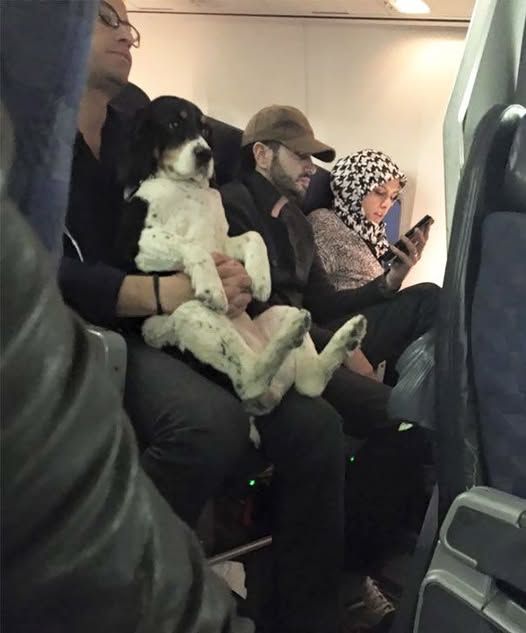Gus’s Quiet Cabin: How One Dog Tamed the Long-Haul Anxiety

The Airbus A380 cabin was a study in controlled chaos: rattling meal carts, blinking screen lights, and the palpable, nervous energy of three hundred strangers sealed in a metal tube for ten hours. In the notoriously cramped confines of economy class, most travelers braced for a predictable ordeal.
But in seat 27B, a different kind of passenger was settling in. This was Mark, a man whose quiet demeanor masked a battle with severe anxiety in enclosed spaces. And nestled comfortably on his lap, a warm anchor in a turbulent environment, was Gus—a gentle, black and white Spaniel mix with soulful eyes and an official Emotional Support Animal vest.

The Unspoken Agreement
Gus was no mere pet; he was a lifeline. His presence was a carefully calculated piece of therapy, a silent shield against the panic that could quickly turn a long-haul flight into a nightmare for Mark. Initially, the sight of a dog—even a perfectly groomed one—in the tight row drew surprised glances. The woman in the aisle seat shifted nervously, and a man across the aisle raised an eyebrow.

However, the mood quickly softened. Gus lay perfectly still, his head resting patiently on Mark’s knee. His rhythmic, soft breathing was a living metronome of calm. The passengers around them, recognizing the quiet importance of the animal’s presence, quickly settled into an unspoken agreement: Gus was essential, and his space was sacred.
The surprising thing was the dog’s subtle, profound effect on the entire section of the cabin. The sheer fact of a non-judgmental, gentle creature being present seemed to lower the collective stress level. People smiled, their weariness momentarily forgotten as they watched the well-behaved animal.
Breaking Down Barriers
Gus was a small, furry angel whose purpose extended beyond his owner. He became an inadvertent focal point of quiet, shared humanity. A young woman next to Mark, deeply engrossed in a novel, unconsciously rested her hand on Gus’s soft, velvety ear. She didn’t look up, yet the simple act of drawing comfort from the momentary, silent connection spoke volumes.
This interaction highlighted a powerful truth: animals often break down human barriers better than we can ourselves. Gus didn’t ask about job stress, or flight delays, or fear of turbulence. He simply offered his warm, unwavering presence—a neutral zone of comfort.

Mark, able to endure the flight thanks to the anchor of Gus, felt the tension in his own shoulders ease not just from the dog’s presence, but from the surrounding compassion. He realized that true compassion often involves making space—both physically and emotionally—for the unique needs of others.

Gus was a silent testament to the fact that not all wounds are visible, and not all support comes in human form. His calm demeanor was the steady, non-judgmental stability Mark needed to endure the journey home. As the plane finally began its descent, Gus lifted his head, gave Mark a reassuring nudge, and settled back down—his mission accomplished. He had not just made a daunting trip bearable for his owner, but had, by his mere presence, given a whole section of the aircraft a moment of unexpected, profound peace.
